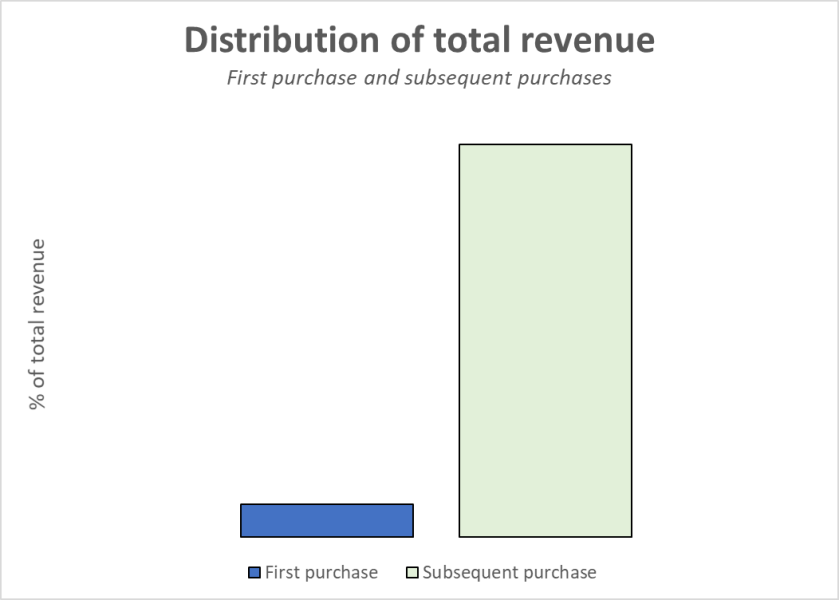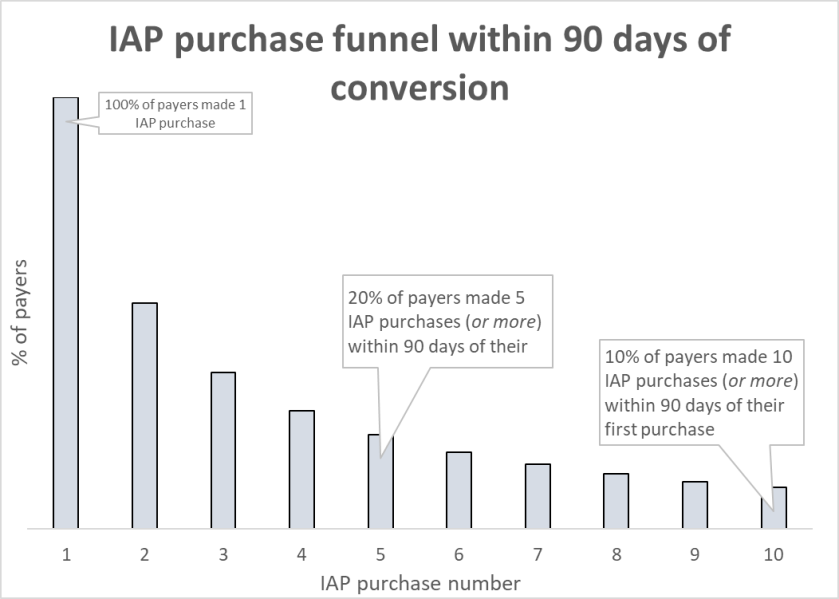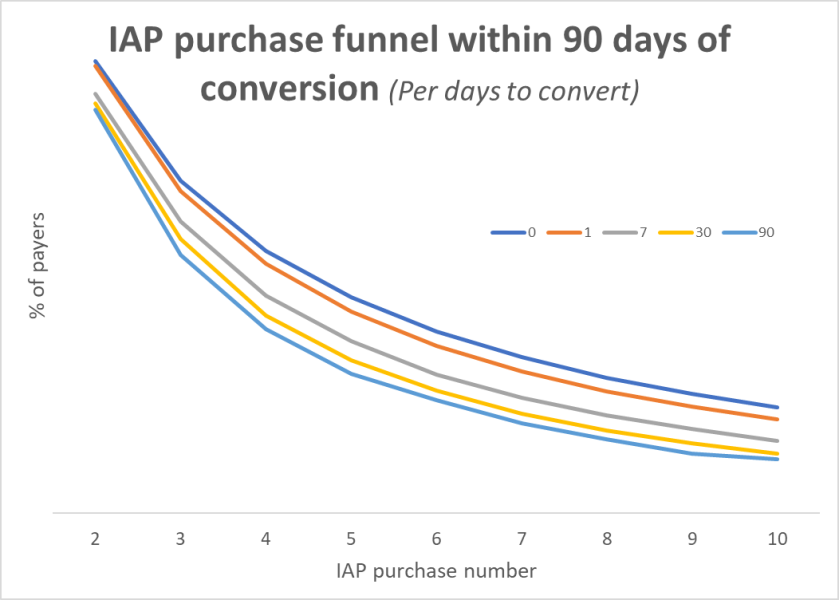In order for your game to monetize, you need players who are willing to spend. That’s why conversion is such a crucial metric to track (especially in the first few days following install). That’s also why you need to be focusing on your customers. They are the segment of players who have the highest predisposition to spend. In a way, making a purchase (ever) is a clear way your biggest fans are auto-identifying themselves as such.
However, while sustained monetization does to a certain extent depend on volume of customers (i.e. the number of installs spending), it’s mostly about depth: about repeat spending from your fans. It’s easy for you to observe that in your game. You can look at what percent of your revenue comes from the first purchase compared to the percent of revenue coming from repeat purchase. The very large majority of your game’s revenue comes from repeat purchases.

It can also be interesting to see how this trend for revenue compares to the trend you see when looking at the number of transactions. While very little of your title’s overall revenue comes from the “conversion purchase”, this first purchase accounts for a much higher percent of the overall IAP transactions that occurred in your game. The reason for this discrepancy is pretty straightforward. Relatively speaking, there are more first purchases because a non-negligible portion of converting users just convert once.

Basically what all this clearly shows is that getting installs to convert and make a first purchase is clearly important. But just getting an install to convert is not enough. It’s a necessary but not sufficient condition to successfully monetize your game. You need to be aiming for conversion, but more importantly you need to be focusing your efforts on your paying users to ensure they want to spend again. Conversion is crucial. But not a volume play. It’s not about how many people you get to spend in your game. Ultimately, it’s about how many quality payers you are able to generate and sustain over time.
So, you can “artificially” increase conversion by going for low price-points. But that won’t help you generate high quality payers who will continue spending regularly over extended periods of time. You can’t really artificially generate your “regulars”: the faithful fans who love your game and spend repeatedly. You need to provide value. (on top of that, if you go for low conversion bundles, you might miss out on the – in the grand scheme of things admittedly small – revenue coming from your first purchases.
In the following few posts, I want to discuss a few useful ways (at least for me) to think about redeposits. And by extension how looking at things in a specific way can help you tailor your monetization strategy and actions.
Think about repeat purchases as a funnel
There is an incompressible amount of installs who will never spend no matter what you do. By that I mean if you are a mass market free-to-play game with large volumes of installs you will never be able to get 100% conversion – probably not even 20 or 10%. In the same vein there is an incompressible amount of paying users you will never get to make a second purchase (it’s not about your game, it’s about them). So, one important thing to keep in mind here is that a significant percent of players who make a purchase will only make that one, first purchase. You are probably looking at 35-45% of paying users who only ever make one IAP transaction ever. There is a point where grit can become unrealistic and counterproductive. So, I would advise against making it a goal to get all your paying users to redeposit. Focus your effort on the highest ROI actions.
When you are thinking about redeposits, think about IAP transactions as a funnel – a bit like you would do for your tutorial funnel. What percent of players making a first purchase make a second one, a third one, a fourth one, etc. Generally speaking – in order to be consistent and yield the best actionable insights possible – when you are trying to get a sense of repeated user action it’s important to consider a specific timeframe. So, if you are thinking redeposit you should be thinking redeposit within how many days from the first purchase (rather than time since install). If you look at it for your game, your purchase funnel will probably look like something below

As an added bonus (and related to the comment above about why you should observe redeposit patterns relative to the first IAP purchase rather than install moment) here you can see how time to convert plays a critical role in redeposit patterns. Usually, the later since install conversion occurs, the less likely those customers are likely to redeposit. That’s just another illustration why you should focus on getting your most engaged fans (and players with the biggest potential) to make their first IAP soon after install.

These visualizations are important because they allow you to go beyond the conversion metric (or even redeposit) to get a sense of your players’ spending pattern. It also provides a good tool to compare various games, or the evolution of a given game over time.
You can also use this funnel view to get a sense of the target purchases you should be aiming for. Specifically, you can look at the “purchase dropoff”. By this I mean (and again, keep the tutorial funnel analogy in mind) the percent of players who are making a purchase, but who don’t eventually go on and make another IAP transaction.

In the example above, you can see that approximately 20% of customers who have made 4 purchases will not go on and make a fifth one. And only approximately 10% of players who have done 12 IAP purchases will not make IAP purchase n.13.
This is pretty intuitive: the more a player purchases, the more likely s/he is to continue spending in the future. The advantage of this visualization is that it provides the tools to quantify that and define targets. If your goal is to try to get players to become regular customers, you can look at this visualization and determine the appropriate number of purchases you should be aiming for. In the example above, you can observe that the “purchase dropoff” at the second IAP transaction is still relatively high (around 30%). Maybe you are more comfortable aiming to get players at a point where the dropoff is lower (say 4 purchases – the dropoff then is at 20%). You then know you should be trying as much as possible to either hand craft a payer journey to reinforce the first 4 purchases, or alternatively target customers who have done 2 or 3 IAP purchases with a special offer – or a combo of offers.
So looking at the purchase funnel not only provides a metric that can allow you to compare purchase patterns across games or time. If you look at the purchase dropoff, you can determine the amount of target IAP purchases you should be aiming for to better constitute a basis of repeat customers. Making 1 IAP purchase is not enough for what you should be aiming for – and more likely than not neither is 2.
Most of the F2P monetization advice around doesn’t cut it; your’s is convincing and accurate to what we see in actual data. Great stuff Alexandre!
Thanks for the kind words!